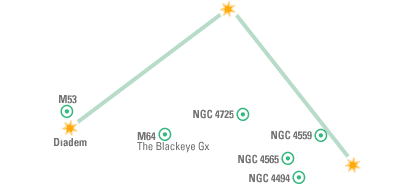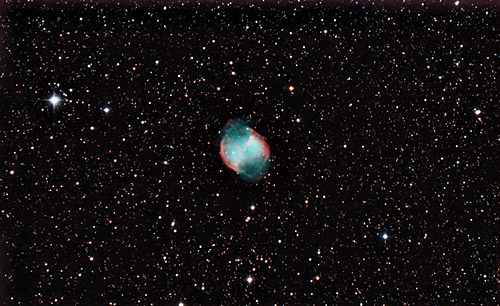 |
||||||||||||||||||||||||||||||||||||||||||||||||||||||||||||||||||||||||||||||||||||||||||||
|
If you have trouble viewing this newsletter, click here. Welcome again to our monthly newsletter with features on exciting celestial events, product reviews, tips & tricks, and a monthly sky calendar. We hope you enjoy it!
If you don’t spend much time browsing obscure Web sites or watching cable TV, you might be unaware that the end of the world is supposed to be happening on December 21, 2012. I wasn’t aware of this myself until I started hanging out on Yahoo! Answers, a Web site where people can post questions and other people can answer them. Much to my surprise, I discovered that the year 2012 features in no fewer than 8,429 questions posed in the last year or so! Prophets have been predicting Doomsday for millennia. In fact, there is a Web site listing over 200 specific dates on which the world was predicted to end. Every single one of these Doomsdays has come and passed, yet the world and its inhabitants have survived unscathed every time. It thus becomes very difficult for anyone familiar with history to take these predictions seriously. The evidence for this latest Doomsday supposedly comes from many different sources, and is thus supposed to be convincing. Yet each of these separate indicators, when examined closely, falls apart. Here, I’ll use Starry Night® and a little astronomical knowledge to demolish one line of evidence. One of the things which is supposed to happen on December 21, 2012 is that the Earth and Sun are supposed to line up with the Milky Way’s equator. So the first question should be, “What is the galactic equator?” Unlike a planet, a galaxy is not a nice neat spheroid, but is an irregular lumpy mass of stars, gas, and dust. It’s somewhat symmetrical, but trying to draw an equator on it would be like nailing jelly to a tree. What astronomers have done is to create an arbitrary line roughly across the centre of our galaxy, and have defined that as the galactic equator. This work was started by Harlow Shapley about 90 years ago and, while it’s been refined somewhat over the years, it still is a very arbitrary line. It was officially defined by the International Astronomical Union in 1959, but it is there by definition, not based on any physical characteristics or markers. So let’s go to Starry Night®, where the galactic equator is located based on the IAU definition.
As expected for the solstice, the Sun is right on the intersection of the green ecliptic equator and 270° grid line. It also looks pretty much as if the Sun is also sitting on the blue galactic equator, though remember that that’s just an arbitrary line drawn on the sky. Let’s zoom in closer, to 15°:
Now you can see that things aren’t fitting quite so nicely. The Sun’s still on the ecliptic grid, but it’s slipped off the galactic equator. Even if it’s on the galactic equator, remember that this is an arbitrary line. If you measure it, you’ll find that the Sun is over 6° away from the real centre of the Milky Way. Unlike the galactic equator, this is a real reference point in the sky, the Sagittarius A radio source and the place where the Chandra X-ray telescope has imaged the center of the Milky Way, 26,000 light years away. Even if this “alignment” didn’t have a 6° kink in the middle of it, there’s the further question as to what might be the significance of having both the Sun, which the Earth orbits, and our galaxy’s black hole, which the Sun itself orbits, line up. The answer is: not very much. Gravitational effects are primarily determined by distance. This means that our Moon, though a tiny body, is the primary cause of the ocean tides. The Sun, while far larger, is so much farther away that its effect of the tides is very small. While our galaxy’s black hole is hugely massive, it’s so much farther away from us than the Sun that its effect on the Earth is totally negligible. I’ve looked at a number of the other pieces of evidence for December 21, 2012 being a significant date, both astronomical and archaeological and, when closely examined, like the “galactic alignment,” they vanish into thin air. All of this predicting Doomsday might be considered harmless, were it not for the events surrounding Comet Hale-Bopp in 1997. Then, the predictions of immanent disaster led to the death by suicide of 39 members of the Heaven’s Gate cult. I am deeply concerned that the promoters of this 2012 Doomsday “event” might precipitate another such deadly massacre. On December 22, 2012, the world will still be here, as it has survived the 200 plus previous “Doomsdays,” but I fear that another Heaven’s Gate may have occurred. Geoff Gaherty
In 2004, NASA's Opportunity rover found evidence in Martian soils that water had once flowed across the surface there, buoying hopes that the red planet may once have supported primitive life. But a new study throws some cold water, and a big pinch of salt, on those hopes.
Tosca and his team analyzed salt deposits in the 4-billion-year-old Martian rock investigated by Opportunity (and by spacecraft orbiting the planet). The new analysis shows that the water that would have flowed across these ancient Martian rocks may have been exceedingly briny. "Our sense has been that while Mars is a lousy environment for supporting life today, long ago it might have more closely resembled Earth," said Andrew H. Knoll, also of Harvard and on the study team. "But this result suggests quite strongly that even as long as four billion years ago, the surface of Mars would have been challenging for life. No matter how far back we peer into Mars' history, we may never see a point at which the planet really looked like Earth." The research was presented in February at the annual meeting of the American Association for the Advancement of Science in Boston. Halophiles, or organisms that can tolerate high-salinity waters, are known to exist in places on Earth, but they likely evolved from organisms that lived in purer waters, scientists think, making it unlikely that life would actually arise initially in extremely briny waters. The high salinity, however, "doesn't rule out life forms of a type we've never encountered," Knoll added, "but life that could originate and persist in such a salty setting would require biochemistry distinct from any known among even the most robust halophiles on Earth." Knoll and Tosca also say the finding doesn't rule out the possibility that less salty waters once flowed on the planet, though Meridiani Planum, where the Opportunity rocks were found, is believed to have been one of the wetter, more hospitable places on the planet. Further reading:
Andrea Thompson
The David Dunlap Observatory, founded in 1935 as a gift to the University of Toronto by Jessie Dunlap in her husband's memory, has been an active research facility for over seventy years, and is about to be sold to the highest bidder. The university will ensure that the legacy lives on in the form of the Dunlap Institute, a proposed centre for theoretical astrophysics, but the fate of the observatory site in Richmond Hill, Ontario hangs in the balance.
The city of Richmond Hill made a bid to purchase part of the property, but was turned down; City Council has been doing research into getting historical designation that would protect the site. You can follow the minutes of City Council meetings on their website. See the News and Meetings sections for details. Local environmental groups are not taking this lying down either, as the observatory property includes two hundred acres of undeveloped wild parkland. It is one of the largest patches of urban parkland in all of Ontario. Hiking trips, protest rallies, and petitions have all been organized by the Richmond Hill Naturalists and other community groups in order to raise awareness of the fact that their green space and wildlife habitat may soon be replaced by commercial or residential development. Finally, the Royal Astronomical Society of Canada has close ties to the Dunlap Observatory, as the University of Toronto's Dr. Clarence Chant was the driving force behind the founding of both institutions. RASC members have volunteered their time and telescopes for years of public education and outreach on the observatory grounds. In May of 2008, the RASC's Toronto Centre published a feasibility study to assist any future owner of the property in preserving the facilities, telescopes, educational programs, and undeveloped land. You can read more about the proposed Observatory Park at their website. The DDO is still a highly-regarded research facility; in 2006 alone, nineteen papers were published on observations from the same telescope that led to Dr. Tom Bolton's discovery of the first known black hole in 1971. Research using that telescope will continue until sometime this summer. The popular public tours and amateur astronomy nights on the lawn have already ended – a tragic loss for a large urban centre with lots of light pollution and no large planetarium. Brenda Shaw
At this time of year, Coma Berenices hangs high overhead, very well-placed for observation. Berenice was an Egyptian queen, the wife of King Ptolemy III Euergestes. When her husband went off to war, to ensure his safe return, she promised her hair to Aphrodite. The King did indeed return and Berenice gave up her hair, a tuft of which became this constellation. Diadem is a binary star about 47 lightyears from us. It's two suns cannot be split in telescopes but, just a little to the north, M53 hangs in space at a much greater distance: 60,000 lightyears. M53 is a halo cluster, filled with dozens of Mag 13 stars. M64, The Blackeye Galaxy, gets its famous name from the dark dust lane that cuts through the galaxy's core. With averted vision, you'll just be able to make out the lane. Overall, the galaxy is bright enough to be visible in binoculars. NGC 4725 is a large bright spiral galaxy which has been warped by its interactions with close-by NGC 4747. This patch of sky also contains the North Galactic Pole. NGC 4559, a faint spiral galaxy, is inclined 20° from edge-on. The larger your scope the better the view. NGC 4565 is inclined only 4° from edge-on and is breath-taking. Both galaxies belong to the Virgo Cluster. NGC 4494 is an elliptical galaxy whose core rotates very rapidly—and in the opposite direction to the stars in the outer disk! Sean O'Dwyer
The Dumbbell Nebula (Messier 27) taken over two nights by Any D'Arienzo. Number of subs: 117
PRIZES AND RULES: We would like to invite all Starry Night® users to send their quality astronomy photographs to be considered for use in our monthly newsletter.
Please read the following guidelines and see the submission e-mail address below.
|
JUN 2008
|
|||||||||||||||||||||||||||||||||||||||||||||||||||||||||||||||||||||||||||||||||||||||||||
 |
||||||||||||||||||||||||||||||||||||||||||||||||||||||||||||||||||||||||||||||||||||||||||||
|
|
||||||||||||||||||||||||||||||||||||||||||||||||||||||||||||||||||||||||||||||||||||||||||||
You have received this e-mail as a trial user of Starry Night® Digital Download
or as a registrant at starrynight.com. To unsubscribe, click here.








